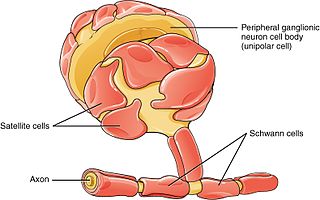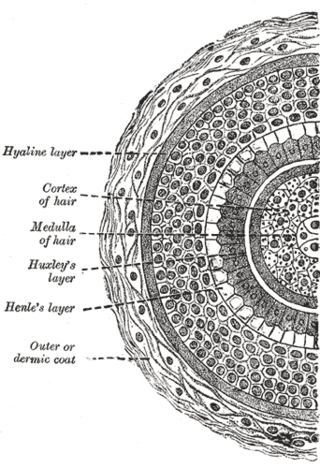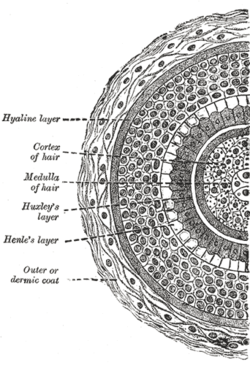
Thomas Henry Huxley was an English biologist and anthropologist who specialized in comparative anatomy. He has become known as "Darwin's Bulldog" for his advocacy of Charles Darwin's theory of evolution.
Sheath pronounced as, may refer to:

Schwann cells or neurolemmocytes are the principal glia of the peripheral nervous system (PNS). Glial cells function to support neurons and in the PNS, also include satellite cells, olfactory ensheathing cells, enteric glia and glia that reside at sensory nerve endings, such as the Pacinian corpuscle. The two types of Schwann cells are myelinating and nonmyelinating. Myelinating Schwann cells wrap around axons of motor and sensory neurons to form the myelin sheath. The Schwann cell promoter is present in the downstream region of the human dystrophin gene that gives shortened transcript that are again synthesized in a tissue-specific manner.

Friedrich Gustav Jakob Henle was a German physician, pathologist, and anatomist. He is credited with the discovery of the loop of Henle in the kidney. His essay, "On Miasma and Contagia," was an early argument for the germ theory of disease. He was an important figure in the development of modern medicine.

The hair follicle is an organ found in mammalian skin. It resides in the dermal layer of the skin and is made up of 20 different cell types, each with distinct functions. The hair follicle regulates hair growth via a complex interaction between hormones, neuropeptides, and immune cells. This complex interaction induces the hair follicle to produce different types of hair as seen on different parts of the body. For example, terminal hairs grow on the scalp and lanugo hairs are seen covering the bodies of fetuses in the uterus and in some newborn babies. The process of hair growth occurs in distinct sequential stages: anagen is the active growth phase, catagen is the regression of the hair follicle phase, telogen is the resting stage, exogen is the active shedding of hair phase and kenogen is the phase between the empty hair follicle and the growth of new hair.

Henle's layer is the third and the outermost layer of the inner root sheath of the hair follicle, consisting of a single layer of cubical cells with clear flattened nuclei. It is named after German physician, pathologist and anatomist Friedrich Gustav Jakob Henle.
In mammals, trichocytes are the specialized epithelial cells from which the highly mechanically resilient tissues hair and nails are formed. They can be identified by the fact that they express "hard", "trichocyte" or "hair" keratin proteins. These are modified keratins containing large amounts of the amino acid cysteine, which facilitates chemical cross-linking of these proteins to form the tough material from which hair and nail is composed. These cells give rise to non-hair non-keratinized IRSC as well.

The inner or epidermic coat of the hair follicle is closely adherent to the root of the hair, and consists of two strata named respectively the outer and inner root sheaths.
The inner root sheath or internal root sheath of the hair follicle is located between the outer root sheath and the hair shaft. It is made of three layers: Henle's layer, Huxley's layer, and the cuticle.
The outer root sheath or external root sheath of the hair follicle encloses the inner root sheath and hair shaft. It is continuous with the basal layer of the interfollicular epidermis (skin).

Hair diseases are disorders primarily associated with the follicles of the hair. A few examples are:
The hair matrix, or simply matrix, produces the actual hair shaft as well as the inner and outer root sheaths of hair.

Loose anagen syndrome, also known as loose anagen hair syndrome, is a hair disorder related to dermatology. It is characterised by the easy and pain free detachment of anagen staged hairs from the scalp. This hair condition can be spontaneous or genetically inherited.
Central centrifugal cicatricial alopecia (CCCA), is a type of alopecia first noticed in African Americans in the 1950s and reported by LoPresti et al. in 1968 as a result of application of petrolatum followed by a stove-heated iron comb. The original theory was that the hot petrolatum would travel down to the hair root, burn the follicle, and after repetitive injury scarring would result. Later CCCA was realized to affect men and women without a history significant for use of such styling techniques. Consequently, the terms "follicular degeneration syndrome" per Sperling and Sau in 1992 and then CCCA per Olsent et al. in 2003 were evolved. Plausible contributing factors may include other African-American styling techniques such as relaxers, tight braids, heavy extensions, certain oils, gels or pomades.
Hair casts represent remnants of the inner root sheath, and often occur in great numbers and may mimic nits in the scalp.
KRT73 is a keratin gene. It is responsible for hair formation, along with other genes, and it encodes a protein present in the inner root sheath of hair follicles.
KRT72 is a keratin gene. It is responsible for hair formation, and it encodes a protein present in the inner root sheath of hair follicles.

KRT71 is a keratin gene. Keratins are intermediate filament proteins responsible for the structural integrity of epithelial cells and are subdivided into epithelial keratins and hair keratins. This gene encodes a protein that is expressed in the inner root sheath of hair follicles. The type II keratins are clustered in a region of chromosome 12q13.

Trichohyalin is a protein that in mammals is encoded by the TCHH gene.
Root sheath may refer to any of these biological structures:








